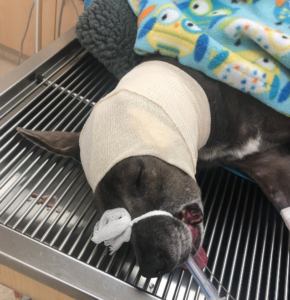 For some procedures, your pet will need to be administered general anesthesia so they will be unconscious and not feel pain. Many pet owners worry about their pets being administered general anesthesia. We can assure you that modern anesthesia is generally quite safe; to further lower any risk, we perform a physical examination and run blood work ahead of time to catch any underlying health issues. In addition, we follow a specific anesthetic protocol, including monitoring vital signs during the procedure, to ensure the safety of our patients.
For some procedures, your pet will need to be administered general anesthesia so they will be unconscious and not feel pain. Many pet owners worry about their pets being administered general anesthesia. We can assure you that modern anesthesia is generally quite safe; to further lower any risk, we perform a physical examination and run blood work ahead of time to catch any underlying health issues. In addition, we follow a specific anesthetic protocol, including monitoring vital signs during the procedure, to ensure the safety of our patients.
We begin most general anesthetic procedures by administering a sedative to help the pet relax and decrease any anxiety and pain. Next an intravenous drug is given to provide complete anesthesia and place a breathing tube (endotracheal tube) into the patient’s trachea (windpipe). To maintain the state of unconsciousness, we deliver a gas anesthetic in combination with oxygen through the breathing tube. Every animal under general anesthesia has an IV (intravenous) catheter in place. This allows us to provide IV fluids during anesthetic procedures, which helps maintain blood pressure, hydration and kidney health. An IV catheter also allows us to administer life-saving drugs in case of an emergency.
A member of our Technical Team continually monitors your pet during surgery and dental procedure. She monitors your pet’s heart and breathing rates, blood oxygen level, blood pressure, anesthesia level and temperature.
After any anesthetic procedure your pet is still closely monitored. A member of our Technical Team continues to monitor your pet’s breathing and temperature during the entire recovery period.
Please contact us if you have any questions or concerns about your pet receiving general anesthesia or about the procedure for which your pet is scheduled.
